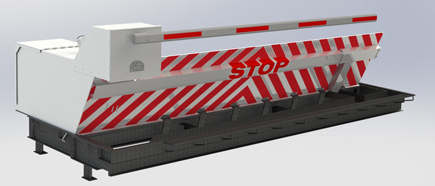Everything about Wedge Barriers
Table of Contents8 Simple Techniques For Wedge BarriersWedge Barriers - An Overview

Unknown Facts About Wedge Barriers
The staying pressure used to
the cam webcam deploy release wedge plate 16 may might provided offered an electromechanical actuator 84 or other various other. The springtime assembly 54 and the actuator 84(e. Wedge Barriers. g., electromechanical actuator)might run together to equate the web cam and lift the wedge plate 16.
As stated above, the spring setting up 54 applies a constant pressure on the webcam, while the electromechanical actuator might be regulated to exert a variable force on the camera, therefore allowing the training and decreasing( i. e., releasing and retracting )of the wedge plate 16. In specific embodiments, the consistent force applied by the spring assembly 54 may be adjustable. g., electromechanical actuator) is handicapped. As will certainly be appreciated, the springtime setting up 54 might be covered and protected from particles or various other aspects by a cover plate(e. g., cover plate 68 shown in FIG. 4) that might be significantly flush with the raised surface 38 of the structure 14. As stated above, in the deployed position, the wedge plate 16 offers to block gain access to or travel beyond the barrier 10. The obstacle 10(e. g., the wedge plate 16 )might obstruct pedestrians or cars from accessing a residential property or path. As discussed over, the obstacle 10 is connected to the anchor 30 protected within the foundation 14,

front braces 71. Consequently, the link settings Full Article up 72 might pivot and rotate to allow the collapse and expansion of the affiliation assemblies 72 during retraction and implementation of the bather 10. The affiliation assemblies 72 cause motion of the wedge plate 16 to be restricted. If a car is taking a trip towards the released wedge plate 16(e. For example, in one scenario, the security legs 86 may be prolonged throughoutmaintenance blog here of the barrier 10. When the safety and security legs 86 are released, the safety and security legs 86 sustain the weight of the wedge plate 16 versus the surface area 12. Because of this, the lifting system 50 may be shut off, serviced, eliminated, replaced, etc. FIG. 5 is partial viewpoint view of an embodiment of the surface-mounted wedge-style obstacle 10, highlighting the web cam 80 and the web cam surface areas 82 of the lifting mechanism 50. Particularly, two webcam surfaces 82, which are referred to as lower cam surface areas 83, are placed listed below the camera 80. The lower webcam surfaces 83 might be fixed to the surface area 12 (e. For instance, the reduced web cam surface areas 83 and the installing plate 85 may form a solitary piece that is protected to the anchor 30 by screws or various other mechanical fasteners. Furthermore, two webcam surfaces 82, which are referred to as top camera surface areas 87, are positioned over the camera 80 and coupled to (e. In various other embodiments, interfering layers or plates may be placed in between the surface area 12 and the reduced camera surface browse around this web-site areas 83 and/or the wedge plate 16 and the upper web cam surface areas 87 As mentioned above, the web cam
80 translates along the webcam surface areas 82 when the wedge plate 16 is raised from the pulled back setting to the deployed setting. Additionally, as discussed above, the spring setting up 54 (see FIG. 3 )might offer a force acting upon the camera 80 in the direction 102 using spring pole 58, which may decrease the pressure the electromechanical actuator 84 is called for to put on the cam 80 in order to activate and lift the wedge plate 16. 1 )to the deployed setting(see FIG. 4). As shown, the camera 80 includes track wheels 104(e. g., rollers), which call and equate along the camera surfaces 82 during operation.